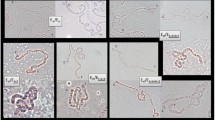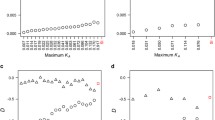Abstract
Sequential electrophoresis, using three different buffer systems on cellulose acetate gels, was used to characterize the allelic variation for esterase-2 in two populations of D. buzzatii in Australia that are separated by 550 km. Twenty-five alleles were detected, of which nine were unique to one population, eight unique to the other, and only eight were common to both populations. Allele frequencies within each population were significantly different between the two major chromosome sequences (standard and j inversion), and for each chromosome sequence allele frequencies were significantly different between populations. Observed allelic frequency distributions were not significantly different from those predicted for selective neutrality using the homozygosity test statistic. However, estimates of the effective sizes of the populations derived from their observed differentiation, together with the history of the species in Australia, provide support for some form of balancing selection affecting at least some of the alleles.
Similar content being viewed by others
References
Barker, J. S. F., 1982. Population genetics of Opuntia breeding Drosophila in Australia, pp. 209–224 in Ecological Genetics and Evolution. The cactus-yeast-Drosophila model system, edited by J. S. F., Barker & W. T., Starmer. Academic Press Australia, Sydney.
Barker, J. S. F., P. D., East & F. B., Christiansen, 1989. Estimation of migration from a perturbation experiment in natural populations of Drosophila buzzatii Patterson & Wheeler. Biol. J. Linn. Soc. 37: 311–334.
Barker, J. S. F., P. D., East & B. S., Weir, 1986. Temporal and microgeographic variation in allozyme frequencies in a natural population of Drosophila buzzatii. Genetics 112: 577–611.
Barker, J. S. F. & J. C., Mulley, 1976. Isozyme variation in natural populations of Drosophila buzzatii. Evolution 30: 213–233.
Barker, J. S. F., F. de M., Sene, P. D., East & M. A. Q. R., Pereira, 1985. Allozyme and chromosomal polymorphism of Drosophila buzzatii in Brazil and Argentina. Genetica 67: 161–170.
Barker, J. S. F., D. C., Vacek, P. D., East & W. T., Starmer, 1986. Allozyme genotypes of Drosophila buzzatii: feeding and oviposition preferences for microbial species, and habitat selection. Aust. J. Biol. Sci. 39: 47–58.
Brady, J. P. & R. C., Richmond, 1992. An evolutionary model for the duplication and divergence of esterase genes in Drosophila. J. Mol. Evol. 34: 506–521.
Chambers, G. K., W. G., Laver, S., Campbell & J. B., Gibson, 1981. Structural analysis of an electrophoretically cryptic alcohol dehydrogenase variant from an Australian population of Drosophila melanogaster. Proc. Natl. Acad. Sci. USA 78: 3103–3107.
Cochrane, B. J. & R. C., Richmond, 1979. Studies of esterase 6 in Drosophila melanogaster. I. The genetics of a posttranslational modification. Biochem. Genet. 17: 167–183.
Collett, C., K. M., Nielsen, R. J., Russell, M., Karl, J. G., Oakeshott & R. C., Richmond, 1990. Molecular analysis of duplicated esterase genes in Drosophila melanogaster. Mol. Biol. Evol. 7: 9–28.
Cooke, P. H. & J. G., Oakeshott, 1989. Amino acid polymorphisms for esterase-6 in Drosophila melanogaster. Proc. Natl. Acad. Sci. USA 86: 1426–1430.
Cooke, P. H., R. C., Richmond & J. G., Oakeshott, 1987. High resolution electrophoretic variation at the esterase-6 locus in a natural population of Drosophila melanogaster. Heredity 59: 259–264.
Coyne, J. A., 1982. Gel electrophoresis and cryptic protein variation, pp. 1–32 in Isozymes: Current Topics in Biological and Medical Research. Vol. 6, edited by M. C., Rattazzi, J. G., Scandalios & G. S., Whitt. Alan R. Liss, Inc., New York.
Dodd, A. P., 1940. The Biological Campaign against Prickly Dear. S. G. Reid, Government Printer, Brisbane.
East, P. D., 1982. Non-specific esterases of Drosophila buzzatii, pp. 323–338 in Ecological Genetics and Evolution. The cactusyeast-Drosophila model system, edited by J. S. F., Barker & W. T., Starmer. Academic Press Australia, Sydney.
East, P. D., 1984. Biochemical genetics of two highly polymorphic esterases in Drosophila buzzatii. Ph.D. Thesis, University of New England, Armidale.
Finnerty, V. & G., Johnson, 1979. Post-translational modification as a potential explanation of high levels of enzyme polymorphism: xanthine dehydrogenase and aldehyde oxidase in Drosophila melanogaster. Genetics 91: 695–722.
Halliburton, R. & J. S. F., Barker, 1993. Lack of mitochondrial DNA variation in Australian Drosophila buzzatii. Mol. Biol. Evol. 10: 484–487.
Keith, T. P., 1983. Frequency distribution of esterase-5 alleles in two populations of Drosophila pseudoobscura. Genetics 105: 135–155.
Keith, T. P., L. D., Brooks, R. C., Lewontin, J. C., Martinez-Cruzado & D. L., Rigby, 1985. Nearly identical allelic distributions of xanthine dehydrogenase in two populations of Drosophila pseudoobscura. Mol. Biol. Evol. 2: 206–216.
Knibb, W. R. & J. S. F., Barker, 1988. Polymorphic inversion and esterase loci complex on chromosome 2 of Drosophila buzzatii II. Spatial variation. Aust. J. Biol. Sci. 41: 239–246.
Knibb, W. R., P. D., East & J. S. F., Barker, 1987. Polymorphic inversion and esterase loci complex on chromosome 2 of Drosophila buzzatii. I. Linkage disequilibria. Aust. J. Biol. Sci. 40: 257–269.
Kreitman, M., 1987. Molecular population genetics, pp. 38–60 in Oxford Surveys in Evolutionary Biology. Vol. 4, edited by P. H., Harvey & L., Partridge. Oxford University Press, Oxford.
Labate, J., A., Bortoli, A. Y., Game, P. H., Cooke & J. G., Oakeshott, 1989. The number and distribution of esterase 6 alleles in populations of Drosophila melanogaster. Heredity 63: 203–208.
Latter, B. D. H., 1973a. The island model of population differentiation: A general solution. Genetics 73: 147–157.
Latter, B. D. H., 1973b. The estimation of genetic divergenea between populations based on gene frequency data. Am. J. Human Genet. 25: 247–261.
Lewontin, R. C., 1985. Population genetics. Annu. Rev. Genet. 19: 81–102.
Mann, J., 1970. Cacti Naturalized in Australia and their Control. S. G. Reid, Government Printer, Brisbane.
Morton, R. A. & R. S., Singh, 1985. Biochemical properties, hemology, and genetic variation of Drosophila “nonspecific” esterases. Biochem. Genet. 23: 959–973.
Mulley, J. C., J. W., James & J. S. F., Barker, 1979. Allozyme genotype-environment relationships in natural populations of Drosophila buzzatii. Biochem. Genet. 17: 105–126.
Nei, M., 1972. Genetic distance between populations. Am. Nat. 106: 283–292.
Nei, M., 1978. Estimation of average heterozygosity and genetic distance from a small number of individuals. Genetics 89: 583–590.
Nei, M., 1987. Molecular Evolutionary Genetics. Columbia University Press, New York.
Nei, M. & W-H., Li, 1980. Non-random association between electromorphs and inversion chromosomes in finite populations. Genet. Res. 35: 65–83.
Nei, M., A., Chakravarti & Y., Tateno, 1977. Mean and variance of F ST in a finite number of incompletely isolated populations. Theor. Pop. Biol. 11: 291–306.
Prakash, S., 1974. Gene differences between the sex ratio and standard gene arrangements of the X chromosome and linkage disequilibrium between loci in the standard gene arrangement of the X chromosome in Drosophila pseudoobscura. Genetics 77: 795–804.
Riley, M. A., S. R., Kaplan & M., Veuille, 1992. Nucleotide polymorphism at the xanthine dehydrogenase locus in Drosophila pseudoobscura. Mol. Biol. Evol. 9: 56–69.
Schafer, D. J., D. K., Fredline, W. R., Knibb, M. M., Green & J. S. F., Barker, 1993. Genetics and linkage mapping of Drosophila buzzatii. J. Hered. 84: 188–194.
Singh, R. S., R. C., Lewontin & A. A., Felton, 1976. Genetic heterogeneity within electrophoretic “alleles” of xanthine dehydrogenase in Drosophila pseudoobscura. Genetics 84: 609–629.
Sokal, R. R., N. L., Oden & J. S. F., Barker, 1987. Spatial structure in Drosophila buzzatii populations: Simple and directional spatial autocorrelation. Am. Nat. 129: 122–142.
Spencer, H. G. & R. W., Marks, 1992. The maintenance of single-locus polymorphism. IV. Models with mutation from existing alleles. Genetics 130: 211–221.
Starmer, W. T. & J. S. F., Barker, 1986. Ecological genetics of the Adh-1 locus of Drosophila buzzatii. Biol. J. Linn. Soc. 28: 373–385.
Strobeck, C., 1983. Expected linkage disequilibrium for a neutral locus linked to a chromosomal arrangement. Genetics 103: 545–555.
Thomas, R. H. & J. S. F., Barker, 1993. Quantitative genetic analysis of the body size and shape of Drosophila buzzatii. Theor. Appl. Genet. 85: 598–608.
Waples, R. S., 1989. A generalized approach for estimating effective population size from temporal changes in allele frequency. Genetics 121: 379–391.
Watt, A. W., 1981. The genetics of temperature tolerance in Drosophila buzzatii, pp. 139–146 in Genetic Studies of Drosophila Populations, edited by J. B., Gibson & J. G., Oakeshott. Australian National University Press, Canberra.
Watterson, G. A., 1977. Heterosis or neutrality? Genetics 85: 789–814.
Watterson, G. A., 1978. The homozygosity test of neutrality. Genetics 88: 405–417.
Watterson, G. A., 1986. The homozygosity test after a change in population size. Genetics 112: 899–907.
Wright, S., 1943. The genetical structure of populations. Ann. Eugenics 15: 323–354.
Author information
Authors and Affiliations
Rights and permissions
About this article
Cite this article
Barker, J.S.F. Sequential gel electrophoretic analysis of esterase-2 in two populations of Drosophila buzzatii . Genetica 92, 165–175 (1994). https://doi.org/10.1007/BF00132535
Received:
Accepted:
Issue Date:
DOI: https://doi.org/10.1007/BF00132535




